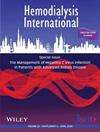Treatment Strategies for Refractory Catheter-Related Central Venous Occlusive Disorders: Review
Abstract
Background
Catheter-related central vein occlusive disease (CVOD) is a frequent complication in hemodialysis patients and significantly affects their prognosis. Current treatment options for catheter-related CVOD include standard guidewire and catheter techniques, radiofrequency ablation, and sharp recanalization. However, large-scale clinical trials evaluating these techniques are lacking, making CVOD management challenging. This article reviews current treatment strategies for catheter-related CVOD.
Methods
A comprehensive literature review was conducted via PubMed, focusing on studies evaluating the effectiveness and safety of various treatment modalities for CVOD. The following keywords were used in PubMed: “hemodialysis”, “central vein occlusion”, “central vein stenosis”, and “catheter”.
Results
The treatment methods for refractory CVOD in hemodialysis patients are diverse, including sharp recanalization, radiofrequency ablation, and percutaneous superior vena cava puncture. Complications and success rates vary widely across treatments, and evidence is generally limited to small studies or case series. However, a standardized treatment protocol is still lacking.
Conclusions
While several techniques show promise in treating catheter-related CVOD, high-quality clinical studies are necessary to identify the more effective and safe procedure. The choice of treatment should be based on individual patient characteristics, extent of the occlusion, and available resources. Percutaneous SVC puncture may be a feasible alternative after failed sharp recanalization for refractory CVOD.

 求助内容:
求助内容: 应助结果提醒方式:
应助结果提醒方式:


